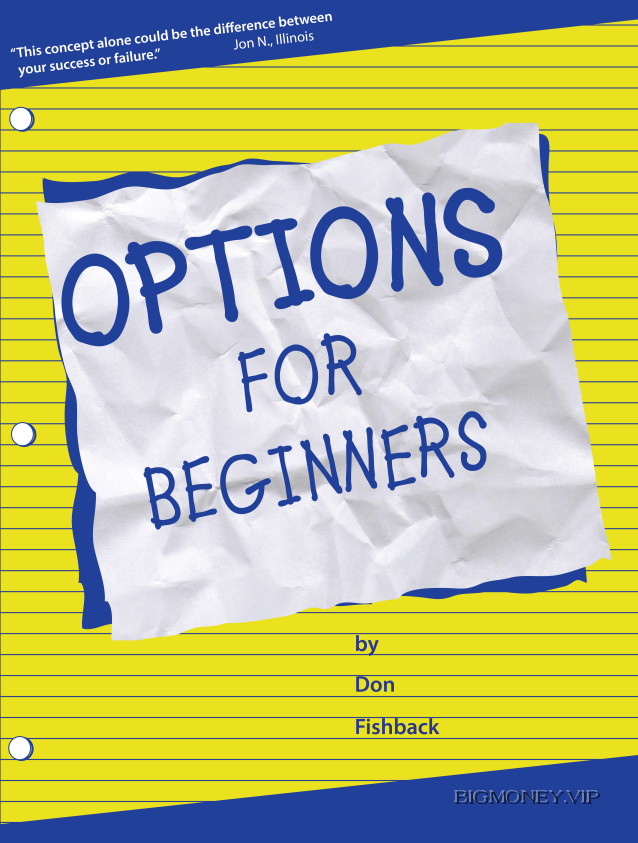Options for Beginners by Don Fishback

You Can Beat The Market If You Control The
Rules
It’s shocking but true. Making money investing can be incredibly difficult.
Investment advisors will tell you that you have to be invested in the stock market
to truly strike it rich. Unfortunately,“buy and hold”does nothing to protect you
from declining markets.
And if you want a safe investment, you sure aren’t going to fnd much infation
protection from bonds or a bank account paying less than 5%. Recently, it’s been
even worse, as some savings accounts have paid less than 1%.
The only true way to make a decent return and stay protected when the market
heads lower is to trade -- that is to buy stocks before the market rises and sell
before the market falls. But based on the performance of most money managers,
even that is extraordinarily difficult.
As noted above, trading boils down to just one simple rule: Buy low and sell
high. It doesn’t matter whether you’re trading stocks, mutual funds, real estate,
collectibles, or options. It’s just that simple.
Although the concept is simple, the implementation has confounded novice
investors, academics and professional traders since the beginning of organized
fnancial markets. That’s because no one has been able to accurately fgure out
how high is high, and how low is low.
Sure, we’ve all seen and heard about those who have beaten the market for
brief periods at a time. But none of them, except for maybe a handful, beat the
market for extended periods. There are numerous studies showing that investors
would be far better off simply investing in a basket of stocks mimicking a stock
index and then doing nothing, instead of placing money with a professional
money manager.
This should not come as a major surprise. One look at the quarterly mutual
fund statistics is evidence enough that even the pros, with billions of dollars in
fnancial market research at their disposal, cannot beat the major market
averages. Hedge funds are no better. It is a sad fact that over the long haul,
about 70% to 80% of all money managers fail to beat the market. In other words,
only 20% to 30% of all market professionals actually earn their management fee.
As if that 20% to 30% fgure wasn’t bad enough, unfortunately, it’s actually a lot
worse. That’s because the 20% to 30% that beat the market one year usually
aren’t the same 20% to 30% that beat the market the next year. For instance, if
you happened to have placed money with a pro who was a top performer in
2007 when the market was going up, there is a high probability that you and
your money manager were slaughtered during the bear market. (Well, at least
you were slaughtered. The money manager still got his fee.) This rotational
aspect to managers means that, over a fve-year span, the probability that a
money manager will beat the market over the course of those fve years is less
than 1/5th of one percent! Here’s a shocking historical example: during the
1990s, there were nearly 5,000 stock mutual funds. During the fve-year period
from the beginning of 1998 through the end of the year 2002, there were only
fve mutual fund managers that beat the S&P 500 each year.
So many people, many of them with millions of dollars in research resources, try
to beat the market. Only a select few actually achieve their objective. That should
tell you how difficult it is to buy low and sell high.
If buying low and selling high is so simple to understand yet so difficult to
implement that virtually no one can do it consistently...
How is it that anyone could honestly expect to master any aspect of trading
from this introductory book?
The key is that we’re going to CHANGE THE RULES! No longer will you simply
buy and sell an asset (an asset would be a stock, a mutual fund or a bond) based
on what you think is going to happen. Rather, we’re going to make an incredible
departure from trying to predict the future.
Instead, this book will introduce you to a way to make money when you think
something will not happen. You’ll learn one simple way to put the odds in your
favor every time you trade. You’ll also learn how to invest just a little to earn a
tremendous amount of money if you’re right, but lose just a little if you’re wrong.
To do this, we need a totally different investment tool, something that gives us
the fexibility to change the rules of investing. The goal of this book is to
introduce you to that tool, and show you how you can use it to make money far
more consistently than you ever thought possible.




